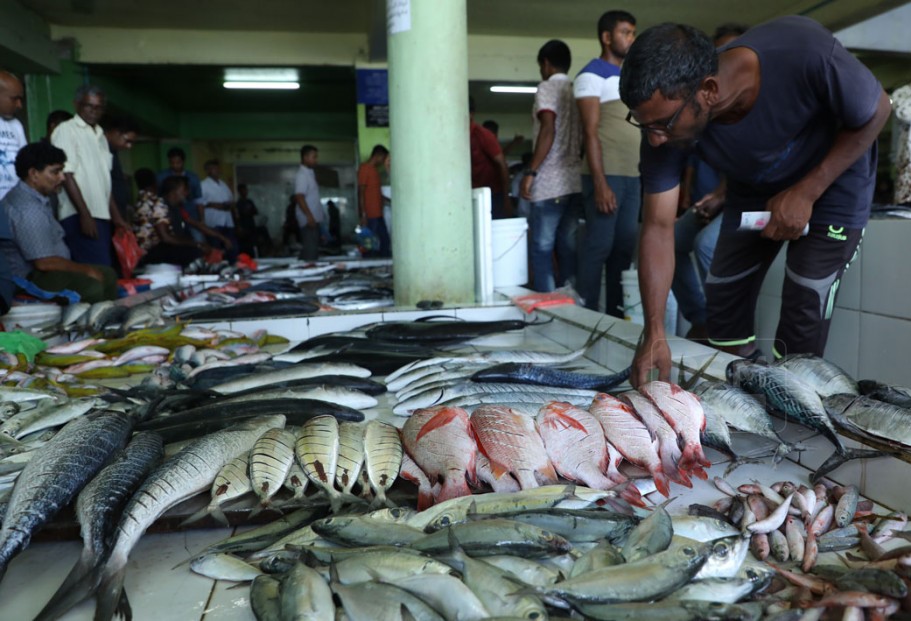The merchandize trade deficit widened from USD 669.3 million in the first quarter of 2023 to USD 768.5 million in the first quarter in 2024; reflecting stronger import and decline in exports.
However, compared to the final quarter last year, merchandize trade deficit in Q1-2024 registered a decline of 6%.
According to the Maldives Monetary Authority (MMA)’s Quarterly Economic Bulletin released on Tuesday, total merchandize exports – comprising of domestic exports and re-exports – register an annual decline of 5 percent in the first quarter this year, reaching a total of USD 131.3 million.
MMA reports that the fall in total merchandize exports was caused due to the steep decline in domestic exports – which has been observing decreases over the last two consecutive quarters as well.
Domestic exports – mainly comrpise of fish and fish products – plunged 41% in Q1-2024, registering a total of USD 31.5 million.
Central bank adds this decline was due to the staggering decline in the export earnings from frozen skipjack tuna, which observed a 64 percent drop – by USD 19.9 million – following declines over the last two consecutive quarters.
Moreover, this decline also in export earnings reflected both the 57 percent decline in the volume of such exports, and the 21 percent drop in skipjack tuna prices in the Bangkok frozen market during Q1-2024.
During the review quarter, frozen skipjack tuna in Bangkok market was priced at an average of USD 1.4 per kilogram – a decline from USD 1.8 per kilogram recorded in the corresponding quarter last year.
Besides this, declines were observed in the export earnings from fresh or chilled yellowfin tuna for the third consecutive quarter.
In the review quarter, export earnings from this commodity dropped by 57 percent (by USD 3.3 million) with the volume of such exports dropping by 55 percent, indicating a decline in unit prices.
Canned and pouched tuna exports saw the opposite trajectory, increasing by 5 percent during the review quarter despite a decline in the volume of such exports.
In tandem with these developments, volume and earnings from frozen yellowfin tuna exports increased, registering an 18 percent growth, a surge by USD 0.6 million), in the review quarter.
The fall in domestic exports was partially offset by the significant rise in merchandize re-exports during the first quarter this year.
In Q1-2024, merchandize re-exports rose by 18 percent, registering a total of USD 99.8 million reflecting the significant growth in jet fuel re-export – which had registered a 17 percent increment.
On the other hand, total merchandize imports observed an annual growth of 12 percent in the review quarter, registering a total of USD 899.8 million.
Major import categories saw modest growths, but was partly offset by a considerable decline in import expenditure on construction-related items; which dropped 9 percent during the Q1-2024.
Among the major import categories thar recorded growths during Q1-2024, the largest increase was observed for import expenditure on petroleum products, which rose by 25 percent – a surge by USD 41.9 million – mainly mirroring the spike in diesel imports, which recorded a susbtantial 27 percent jump (USD 34.8 million) in the review quarter.
Food items saw a growth of 14 percent (USD 23.9 million), while mechinery and mechanical appliances imports saw a 40 percent (USD 23.0 million) growth.
Import expenditure on electrical and electronic machinery and equipment registered a 43 percent growth (USD 19.0 million) during the first quarter.
Despite significant fisheries activities – from the country’s second largest economic sector – the relatively lower revenue receipts from the sector is an industry-wide concern, especially among the fishers who stand to receive the most significant brunt from adverse impacts.
Fishers’ woes do not end here as many face plight of long overdue payments owed to them by processed-fish manufacturers and canneries operating in the Maldives.
Source(s): sun.mv

 News6 days ago
News6 days ago
 News3 days ago
News3 days ago
 World6 days ago
World6 days ago
 News4 days ago
News4 days ago
 Business4 days ago
Business4 days ago
 Tech4 days ago
Tech4 days ago
 News4 days ago
News4 days ago
 News4 days ago
News4 days ago
























